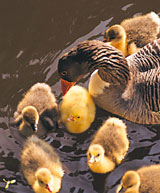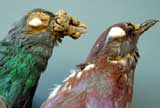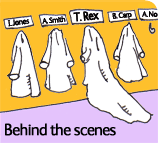The theory
The theory of evolution by natural selection was proposed simultaneously by two different people: Charles Darwin and Alfred Wallace. Both men had studied the natural world extensively and made a number of observations that were critical to the development of the theory.
Wallace and Darwin noted that organisms produced far more offspring than could ever possibly survive. Whether they were looking at tiny insects laying hundreds of eggs or cats giving birth to six kittens they realised creatures were regularly losing a large number of their offspring to disease, predators, and starvation.
While a goose may hatch more than a half-dozen goslings in a season, few will survive their first winter.
They also noticed that not all the individuals belonging to a specific group of organisms (called a species) were identical. While one lion or canary is just the same as any other to the untrained observer, Darwin and Wallace saw there were subtle differences.
Finally, they realised that some of the variations found in a species were inherited by offspring from their parents. Darwin specifically saw this with domestic pigeons that he was breeding at home. While Darwin and Wallace did not understand how this inheritance worked, we now know these variations are based on different genes carried by the organisms.

Darwin found differences in domestic pigeons and bred the birds such that the characteristics became exagerated.
From these observations, Wallace and Darwin simultaneously suggested that since most offspring do not survive the harsh realities of the natural world, organisms must have to struggle for survival. They stated that only those organisms that do survive long enough to reproduce are then able to pass on their characteristics to their offspring. Thus, in time, characteristics that allow organisms to survive and reproduce become more common. Those that don’t will disappear. And so the population evolves.
